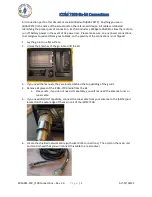
Installation and Setup
47
Instruction Manual – DXLink Fiber Transmitters and Receivers
Scenarios / DIP Switch Settings Table for Unidirectional Mode
Important:
In a standalone pair with mixed hardware (one unit Duplex and the other Simplex), we
recommend setting the Duplex unit to handle Unidirectional communication (set #4 Toggle to ON). In a
switching system with mixed hardware (a mix of Duplex and Simplex boards and units) comprising a
complete switching run, the hardware will only support Unidirectional Mode – we recommend configuring all
hardware accordingly.
The table below contains the most common scenarios for setting up DXLink Fiber, Duplex Transmitters and Receivers
in Unidirectional Mode (also applies to Data Link-lost Mode) and DXLink Fiber, Simplex Transmitters and Receivers as
a standalone pair or with other equipment.
Find the scenario in the table that you want to use and then set the DIP switches accordingly.
A detailed
explanation of functions for each toggle is provided above and on the previous page.
Tip:
Each toggle’s ON position is toward the connectors on the rear of the DXLink Fiber units (see page 44).
Note:
DXLink Fiber, Simplex only -
DIP switch #4 Toggle is non-functional. It can be set to ON or OFF.
* Does not apply for DXLink Fiber, Simplex units: The toggle can be set to ON or OFF.
** Requires ICSLan connection to network.
Important:
When connecting a Transmitter or a Receiver in a standalone pair setup to a Master (or Virtual
Master) for upgrade purposes, #1 and #3 Toggles must be ON. #2 is only required on each unit if serial
and/or IR control is required from the Master.
Mounting Options for DXLink Fiber Units (Rack Trays and Mounting Brackets)
The DXLink Fiber Transmitters and Receivers are classified as V Style modules, which have optional
V Style mounting hardware. These versatile mounting options include rack trays and mounting brackets for desktops,
under desks, on walls, and on poles. For details on V Style Mounting Kit options, see www.amx.com.
Important:
When mounting under a surface, the DXLink Fiber unit should be mounted upright and lowered in
the slots to provide an airflow gap between the surface and the vent holes. If not using V Style brackets, be
sure to leave a gap between the top of the unit and the surface for heat to escape.
Common Scenarios for Unidirectional Mode
DIP Switch Toggle Settings
Endpoint Mode – TX/RX pair direct connection (with Switcher on Network)
#1
#2
#3
#4
AV signals only
OFF
OFF
OFF
ON*
AV with NetLinx control of TX/RX unit and serial/IR ports**
ON
ON
ON
ON*
TX/RX connected to Enova DGX Switcher (Switcher Setup)
#1
#2
#3
#4
AV signals only
OFF
OFF
OFF
ON*
AV with NetLinx control of TX/RX unit and serial/IR ports**
ON
OFF
ON
ON*
Common Scenarios
Table - Unidirectional
Caution:
To prevent overheating, avoid placing high heat producing equipment directly above or below the
units. We recommend allowing plenty of clearance above the vent holes on top of the units. Do not place
anything directly on top of the units that would restrict airflow through the vent holes on top.
FIG. 15
V Style mounting hardware
V Style Single Module
Surface Mount Brackets
V Style Module Tray
V Style Single Module Pole Mount
Do not mount upside down
Leave minimum gap of 3/8 in (9 mm)
















































